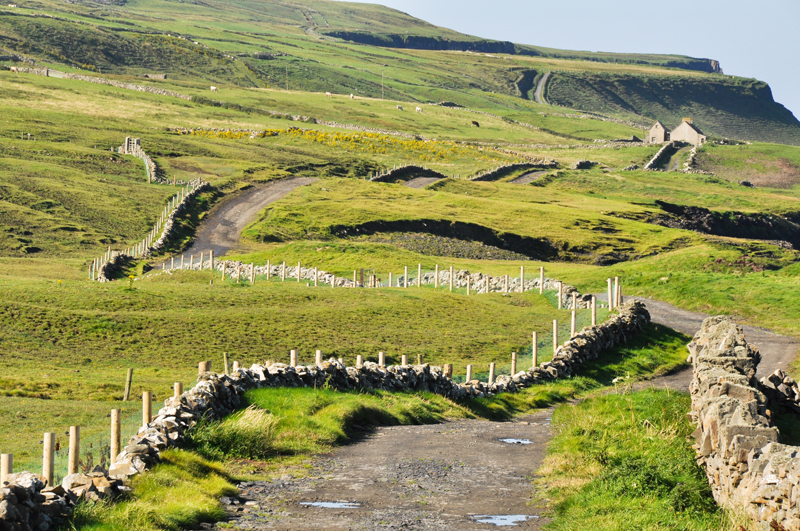The History of Irish Dancing

The history of Irish Dancing takes us back even prior to the time of the Druids, in the early centuries of modern history. The invasion of the Celts from Central Europe brought with it various folk dances, which were quickly incorporated into Druidic rituals , including the “oak tree” and the “sun” dances.
While early Christianity did not encourage or enhance dancing as part of religious services, the peasant population retained much of its previous occultist culture, including dances to various deities and dances aimed as appeasing curses or imploring blessings.
The time span from around 400 AD to the 1300’s has often been claimed as “Ireland’s Golden Age”. The work of St. Patrick and other itinerant monks spread the Gospel of Christianity throughout the land. The Church built its monasteries and schools and birthed the age of Irish learning and education. In spite of the ravages of the Vikings in the 800’s (when all books of learning were destroyed), the Norman Invasion in the 12th century brought new and exciting cultural and custom changes to the country, and it is from this era that we have our first references to the foundations of our modern Irish dancing.
The early dances were simply the impromptu expressions of the Irish natural love for fun and entertainment. The “cake” dance was performed after Sunday services and was in fact perhaps the original “Irish Dance Competition”, in which ordinary men and women vied with one another to win the prize of a freshly-baked cake through the demonstration of intricate and complex steps and maneuvers.
While we can find literary references to the “long dance”, jigs , heys and trenchmores in the mid -1600’s, it isn’t until almost two hundred years later that we begin to see the “organization” of Irish Dancing into the form we recognize today.
The 18th and 19th centuries was the era of the “Dancing Masters” who travelled around the country, staying 6 to 8 weeks in a community, teaching all and sundry ( at least those who were able to pay) the basic forms of the (then) modern dance. Competitions were often organized among these masters to see who would be privileged to teach in the more affluent areas. Afterwards, the local peasantry would join in the fun and it is probably from these humble beginnings that today’s ceili and set dances originate.
While the “dancing masters” continued their work into the late 1800’s, it wasn’t until early in the 20th century that Irish Dancing was first standardized to pre-set forms and movements. With this standardization, many of the regional and local forms were lost, along with much of the history associated with particular area dances. Today the commercialization of Irish Dancing has popularized its worldwide recognition, while throughout Ireland, ceilis and simpler traditional competitions retain much of what is still known as an Irish Culture phenomenon.
While early Christianity did not encourage or enhance dancing as part of religious services, the peasant population retained much of its previous occultist culture, including dances to various deities and dances aimed as appeasing curses or imploring blessings.
The time span from around 400 AD to the 1300’s has often been claimed as “Ireland’s Golden Age”. The work of St. Patrick and other itinerant monks spread the Gospel of Christianity throughout the land. The Church built its monasteries and schools and birthed the age of Irish learning and education. In spite of the ravages of the Vikings in the 800’s (when all books of learning were destroyed), the Norman Invasion in the 12th century brought new and exciting cultural and custom changes to the country, and it is from this era that we have our first references to the foundations of our modern Irish dancing.
The early dances were simply the impromptu expressions of the Irish natural love for fun and entertainment. The “cake” dance was performed after Sunday services and was in fact perhaps the original “Irish Dance Competition”, in which ordinary men and women vied with one another to win the prize of a freshly-baked cake through the demonstration of intricate and complex steps and maneuvers.
While we can find literary references to the “long dance”, jigs , heys and trenchmores in the mid -1600’s, it isn’t until almost two hundred years later that we begin to see the “organization” of Irish Dancing into the form we recognize today.
The 18th and 19th centuries was the era of the “Dancing Masters” who travelled around the country, staying 6 to 8 weeks in a community, teaching all and sundry ( at least those who were able to pay) the basic forms of the (then) modern dance. Competitions were often organized among these masters to see who would be privileged to teach in the more affluent areas. Afterwards, the local peasantry would join in the fun and it is probably from these humble beginnings that today’s ceili and set dances originate.
While the “dancing masters” continued their work into the late 1800’s, it wasn’t until early in the 20th century that Irish Dancing was first standardized to pre-set forms and movements. With this standardization, many of the regional and local forms were lost, along with much of the history associated with particular area dances. Today the commercialization of Irish Dancing has popularized its worldwide recognition, while throughout Ireland, ceilis and simpler traditional competitions retain much of what is still known as an Irish Culture phenomenon.

Related Articles
Editor's Picks Articles
Top Ten Articles
Previous Features
Site Map
Content copyright © 2023 by Tony King. All rights reserved.
This content was written by Tony King. If you wish to use this content in any manner, you need written permission. Contact Bee Smith for details.


